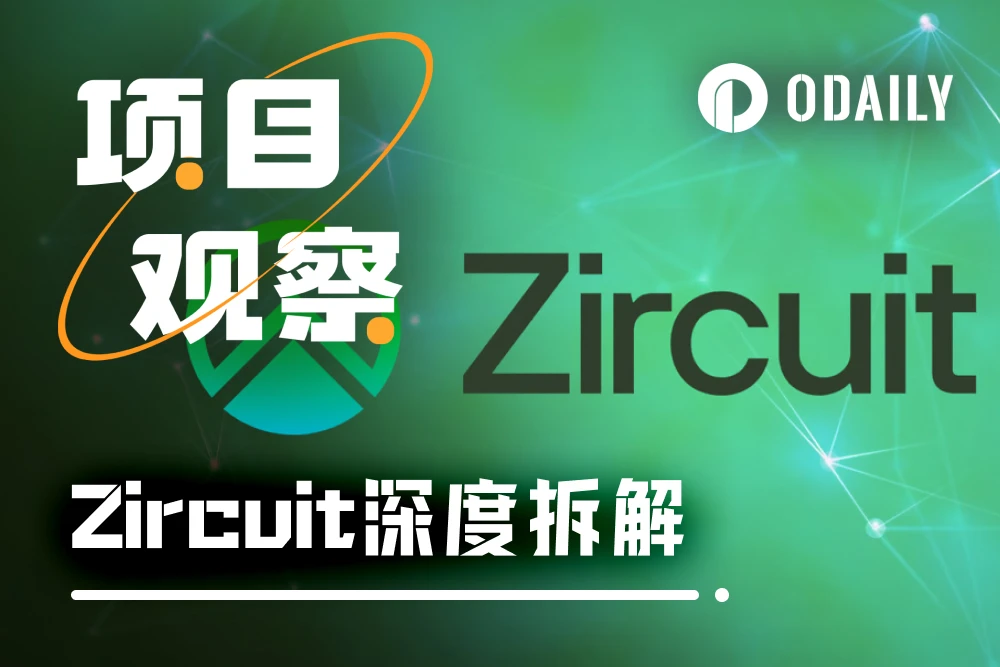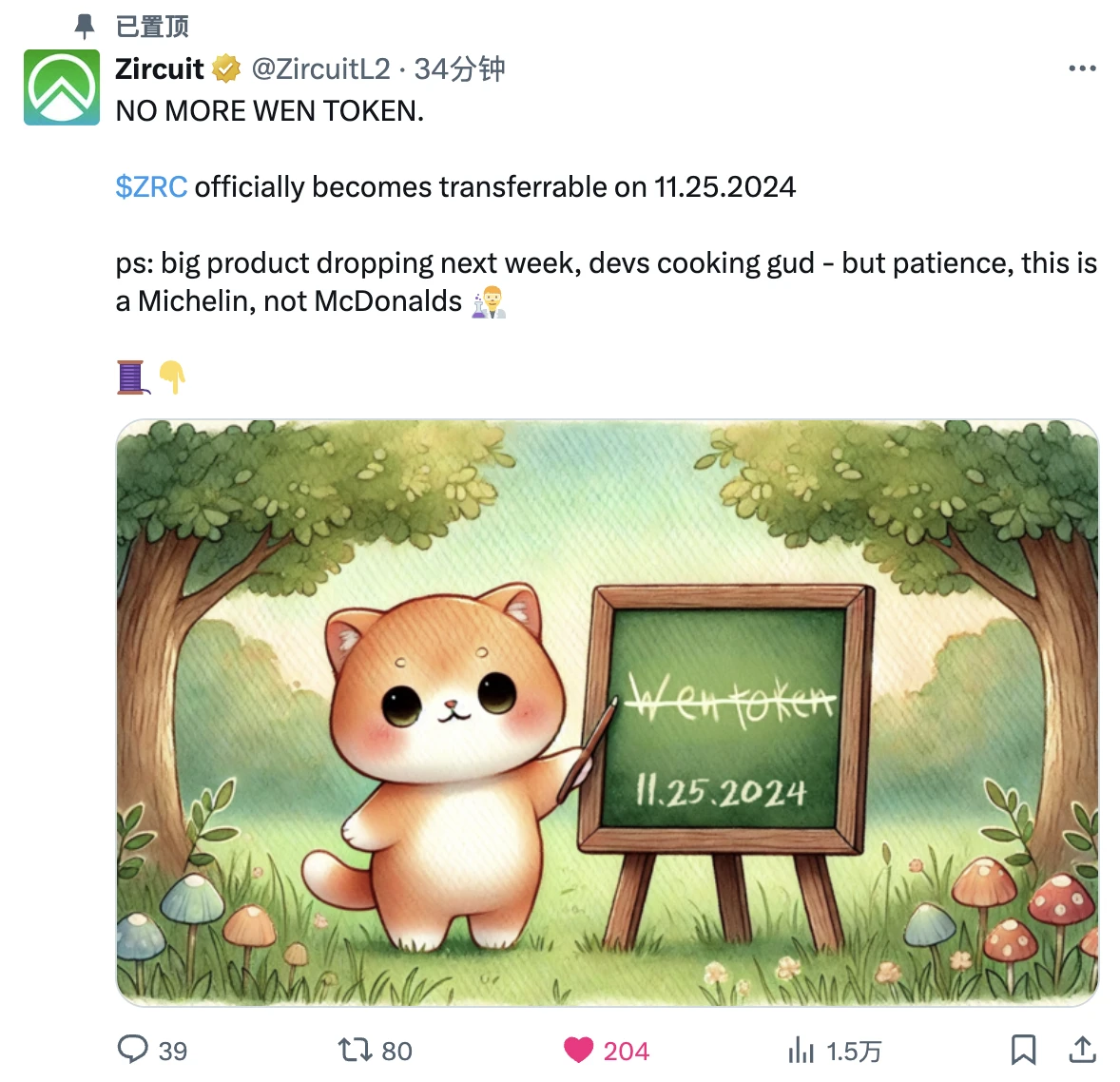
Zircuit, the industrys first ZK Rollup network that integrates AI concepts and has a total TVL value of more than US$2 billion, has been making frequent moves recently.
On October 25, Catizen announced that Zircuit became the first project to land on its Launchpool product.
On October 31, Zircuit and Binance Web3 Wallet jointly launched a Gas subsidy campaign, which will provide Gas rebates to all users who bridge to Zircuit and stake ETH through the Binance Web3 Wallet client.
On November 1, Zircuit announced the launch of the Fairdrop airdrop event, which will airdrop 2% of ZRC tokens to more than 200,000 eligible EIGEN holders and stakers to incentivize early supporters of the restaking vision.
In just a few days, Zircuits governance token ZRC was listed on the pre-market trading markets of leading exchanges such as Bitget, Gate, and Bybit . Real-time data shows that the ZRC token is currently trading at $0.11 on Bybits pre-market trading market (Bitget is $0.1, Gate is $0.082). Based on the total supply of 10 billion tokens, the corresponding valuation is as high as $1.1 billion.
On November 22, Zircuit officially announced that it will lift the transfer restrictions on ZRC on November 25, at which time ZRC will officially enter circulation.

Three unique advantages help Zircuit stand out
In July this year, Zircuit just completed a new round of financing, with Binance Labs, Mirana Ventures, Amber Group, Selini, Robot Ventures, Nomad Capital, Borderless Capital and angel investors from projects such as Renzo, Etherfi, Pendle, Parallel, LayerZero, Axelar, F 2 Pool, Nonce, KelpDAO, ETHGlobal, Maelstrom and others participating in the investment.
Zircuits design cleverly combines multiple concepts such as ZK, AI, and Restaking, so some users may have some confusion in positioning Zircuit. If we were to explain the positioning of the project in one sentence, it might be that Zircuit is a Layer 2 network that takes into account the advantages of Optimistic Rollup and ZK Rollup, uses AI to consolidate network security, and uses Staking and Restaking narratives to activate ecological liquidity.
This positioning outlines Zircuit’s three unique advantages, with the keywords being “OP + ZK”, “AI” and “liquidity”.
Keyword 1: OP + ZK
The so-called OP + ZK refers to the hybrid architecture of Optimistic Rollup and ZK Rollup adopted by Zircuit. The construction of the Rollup network involves various components such as sequencer data publishing, smart contracts, cross-chain bridges, and execution layers. In order to develop more efficiently, Zircuit uses the most mainstream and most fully tested Rollup development framework OP Stack on the market. However, since OP Stack only supports the construction of Optimistic Rollup, in order to advance to a safer and more efficient ZK Rollup, Zircuit removed all components related to the Optimistic model in the framework and replaced them with ZK components.
In this way, although Zircuit is a hybrid architecture from the bottom layer, it is completely a ZK Rollup from the user-side experience. The design of the hybrid architecture not only ensures that Zircuit can complete network construction in a shorter time and in a safer way, but also ensures that Zircuit can jump out of the functional limitations of OP Stack and directly realize the utility of ZK Rollup. In addition, the compatibility of Zircuit and OP Stack also ensures that the network will be able to support Ethereums future upgrades more smoothly in the future, which can help Zircuit follow the development of the Ethereum ecosystem more promptly.
Keyword 2: AI
Compared with all the current Layer 2 networks, the biggest feature of Zircuit is that it is the only Layer 2 that effectively integrates AI mechanisms into the network operation level. Specifically, Zircuit adds the SLS (Sequencer-Level Security) system at the sorter level. The SLS system has a built-in AI evaluation module, which uses the transaction data of all EVM-compatible chains as training data and can autonomously detect and identify suspected malicious transactions.
When a transaction is initiated on the Zircuit network, the AI evaluation module of the SLS system will automatically check whether the transaction is suspected of malicious intent, and all inspection results are completely transparent on the chain. Only after this check is passed will the transaction be included in the block and added to the chain; if the transaction fails the AI check, it will be temporarily isolated, and the security experts of the Zircuit team will further analyze it to eliminate potential protocol vulnerabilities.
In the on-chain world where security incidents occur frequently, Zircuits AI intervention mechanism effectively achieves the advance prevention of security incidents, breaking the passive situation in which the industry can only seek compensation after the fact when facing sudden security incidents, and can greatly improve the security of user assets.
Of course, due to the use of a fully automatic AI intervention mechanism, it is theoretically inevitable that transactions will be accidentally killed. Zircuit has stated that based on test data, the intervention readiness of this module exceeds 99.5%, and ordinary transactions will generally not be confused. As for extreme accidental killing situations, Zircuit also presets a manual intervention mechanism to release transactions that have been temporarily isolated by AI.
Keyword 3: Liquidity
For Layer 1/Layer 2, which started relatively late, how to effectively accumulate early liquidity is a major challenge facing every project.
Zircuits strategy for this is to actively embrace the staking and restaking narrative. Long before the mainnet was launched, Zircuit had opened deposit contracts for ETH and multiple Liquidity Staking Tokens (LST) and Liquidity Restaking Tokens (LRT) on the Ethereum mainnet, allowing users to earn regular staking and restaking income while also receiving certain Zircuit points rewards. This move has enabled Zircuit to attract billions of dollars in liquidity before the mainnet was launched, ranking among the top of all Layer 2 networks.
This is why Zircuit will choose to airdrop 2% of the ZRC supply to EigenLayer ecosystem users after the mainnet is launched, in order to give back to the EigenLayer ecosystem for its contribution to the development of the Restaking concept. It is worth mentioning that Zircuit is also the first project in the Restaking ecosystem to choose to airdrop to non-direct users , which has also won Zircuit a lot of community praise.
Token unlocking is imminent, reviewing the development history of Zircuit
Looking back at Zircuit’s past development history, from the opening of staking in February this year to the official circulation of ZRC on November 25, Zircuit completed the implementation of a Layer 2 network with a liquidity scale of over US$2 billion at an extremely fast execution speed.
In February this year, Zircuit officially opened the staking window on the Ethereum mainnet, where users can participate in the Zircuit ecosystem by staking ETH, ezETH, rswETH, rsETH, LsEtH and stETH, as well as various tasks to obtain Zircuit points;
In August, Zircuit officially announced the launch of the first phase of the mainnet and announced the first quarter airdrop plan. The first quarter airdrop will distribute 7% of the total supply of ZRC tokens, and a total of 262,200 addresses are eligible for airdrops. In addition, Zircuit has reserved 14% of the token share for future airdrops (a total of 21% for airdrops and community rewards), and the second quarter airdrop activity is still in progress.
In October, Zircuit announced that it would launch the Zircuit Liquidity Hub, which will allow users to migrate liquidity from the Ethereum mainnet to Zircuits Layer 2 network, thereby accumulating Zircuit points more efficiently and obtaining a series of rewards such as staking income, protocol tokens, and partner airdrops in one stop. It is worth mentioning that in order to reduce friction during user migration, Zircuit took the initiative to bear the gas costs of migrating from the Ethereum mainnet to Layer 2.
At the end of October, Zircuit announced the launch of the second phase of the mainnet and disclosed that the first batch of $150 million in liquidity had been migrated.
In November, Zircuit accelerated its development pace again. In addition to the aforementioned Fairdrop airdrop and listing on Bitget, Gate, and Bybit pre-markets, the most important milestone is that ZRC will officially lift the token transfer restrictions on November 25. It is worth mentioning that Zircuit also announced that it will release an important product next week, which may bring new surprises to the market.
While delivering and achieving milestone after milestone, Zircuit continues to advance its Build to Earn program to incentivize builders, founders, and community members who contribute to the Zircuit ecosystem, thereby boosting the expansion of Zircuits ecosystem.
A Brief Analysis of the ZRC Token Economic Model
According to the ZRC token economic model disclosed by Zircuit, the total supply of ZRC is 10 billion, and the specific distribution plan is as follows:
21% is used for airdrops and community rewards, which is one of the projects with the highest airdrop ratio among all Layer 2 projects. 7.00% is used for airdrops in the first quarter, 3.00% is used for airdrops in the second quarter, and 2.45% is used for activities (Fairdrop, Catizen, Binance Web3, etc.). All of the above shares will be unlocked at TGE; in addition, 8.55% of ZRC will be reserved for future airdrops and rewards. This part of the shares will have a 6-month and 12-month lock-up period, and then a linear release of 24 months;
13.08% is used for Community Provisions, which will have a 1-year lock-up period and then be released linearly over 24 months;
17.93% will be used for ecosystem development. This portion of the shares will have a 1-year lock-up period and then be released linearly over 24 months;
18.70% will be allocated to the foundation, which will have a 1-year lock-up period and then be released linearly over 24 months;
18.74% will be allocated to the team: this portion of the shares will have a 1-year lock-up period and then be released linearly over 24 months;
10.55% will be allocated to investors: this portion of shares will have a 1-year lock-up period and then be released linearly over 24 months.
21% plus 13.08%, a total of 34.08% of ZRC will be allocated to Zircuit community users, making it one of the projects with the highest community share among all Layer 2 projects. Since the first season airdrop, Zircuit has launched a number of different types of token distribution activities. The completed first season airdrop and the ongoing second season airdrop are expected to be distributed to 342,000 addresses; the airdrop for EigenLayer holders and stakers covers about 203,000 addresses; Catizens Launchpool activities have a total of 105,000 users participating; the activities promoted in cooperation with Binance Web3 wallet have also reached about 40,000 users.
As the track is on the rise, what is the circulation prospect of ZRC?
Looking back at the market trends in 2024, the Layer 2 track has experienced a long consolidation period since the Cancun upgrade was implemented. However, with the sudden rise of ETH on the evening of November 21, multiple Layer 2 tokens such as OP, ARB, and STRK have also achieved an increase of more than 20%. It seems that the Layer 2 track has begun to show an upward trend.
Zircuit chose to lift the transfer restrictions of ZRC on November 25. Although it was not intentional (it can be seen from the pre-market launch in the early stage that this was already being prepared), it happened to catch up with the track-level trend that may appear in the future . In addition, Zircuit, which is superimposed with triple BUFF such as AI, is itself a rare innovative project with unique highlights in the slightly stereotyped Layer 2 track. ZRCs future performance may be worth looking forward to.










